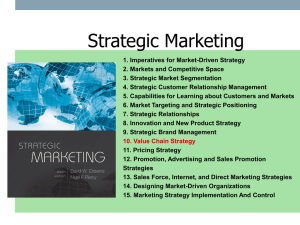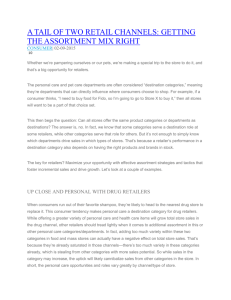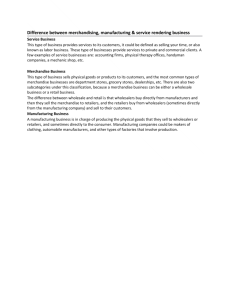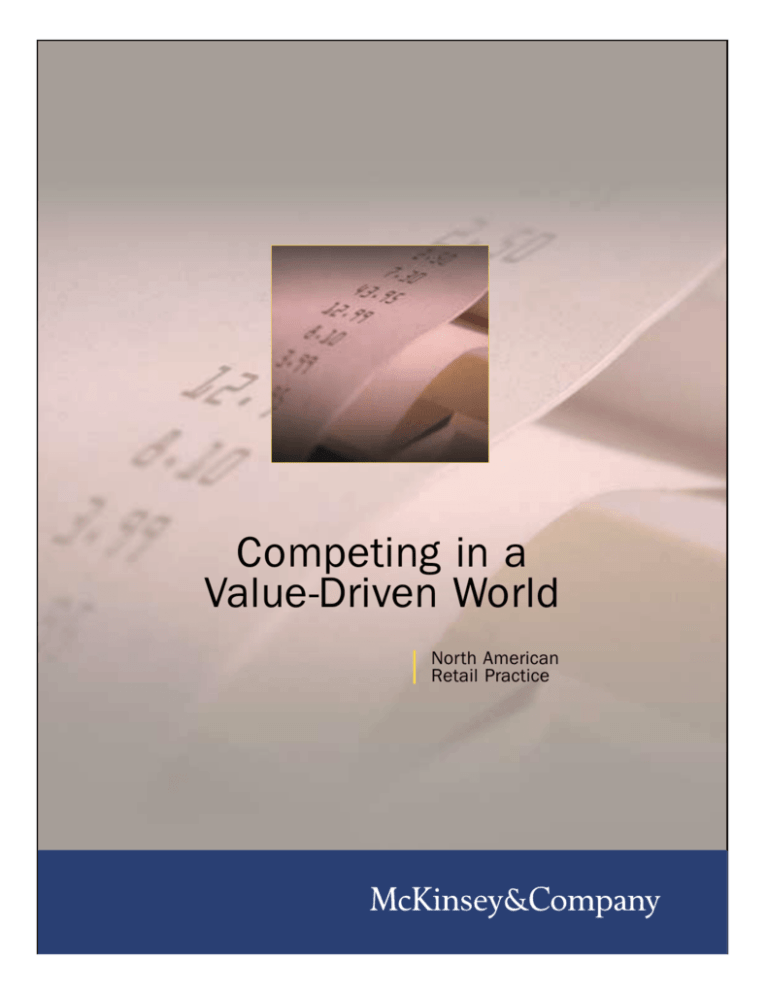
Competing in a
Value-Driven World
North American
Retail Practice
Competing in a
Value-Driven World
Robert J. Frank, Elizabeth A. Mihas, Laxman Narasimhan, Stacey Rauch
A hand-to-hand battle for survival lies ahead for many U.S. retailers. It arises from a basic
structural change now taking place in the industry, a change largely camouflaged by the
recent economic downswing. McKinsey’s Global Institute has recently concluded that
U.S. retailers are among the world’s most productive,1 yet these retailers have been
plagued by low consumer confidence and their senior management has looked to a
rebounding economy for a bailout. However, a recharged economy is unlikely to help.
Simply put, the retailing landscape itself has changed, with the fundamental and ongoing
shift of consumer spend to value retailers.2 Now, and in the future, success for U.S.
retailers will mean learning how to compete in a value-driven world.
The Challenge: Consumer Shift to Value
Value retailers like Wal-Mart, Target and Costco were once largely known as the
destination for the monthly stock-up trip. But today, they have penetrated the
routine weekly shop. Our proprietary consumer research3 shows that this
consumer “shift to value” cuts across all ages, nearly all income groups and, to
some degree, all consumer segments. A majority of consumers surveyed shop at a
value retailer every week. As a result, whole categories have “gone to value,” with
value retailers nearly doubling their share of U.S. retailing over the last 10 years
(Exhibit 1).
What explains this dramatic shift? There are two interrelated factors:
First, consumers have fundamentally changed their reference points for both price
and quality. Consumers have been trained to expect significantly lower prices at
value retailers. Further, they no longer see the price premium demanded by
traditional retailers as compelling across many different categories. As life styles
have become more casual, many consumers have redefined quality from “good”
Exhibit 1
VALUE RETAILERS HAVE ALMOST DOUBLED SHARE IN PAST DECADE
U.S. retail sales 1992-2001
Percent share; $ Billions
CAGR
Percent
100% = $1,627.0
Miscellaneous
7.1
Mail order/Internet
2.2
Department stores
5.2
Health and personal care
5.6
$2,631.0
5.5
Apparel
7.0
6.7
4.0
3.2
6.5
5.7
Gas
9.6
9.0
4.7
Foodservice
12.5
12.2
5.2
Hard goods
17.8
17.3
5.2
18.0
2.7
Food & beverage
22.8
Value retailers*
10.2
17.4
12.0
1992
4.7
13.1
0.1
7.2
3.0
2001
* Value retailers include mass merchandisers, warehouse, dollar, and big box stores
Source: Annual Benchmark for Retail Trade; U.S. Bureau of Census; Morgan Stanley, May 2002; McKinsey analysis
to “good enough” for certain items and occasions, such as the casual weekend
wardrobe. And value retailers like Kohl’s and Target have upped the ante by
increasing access to popular brands at value prices and upgrading the quality of their
private label offering. This closing of the perceived gap in quality has allowed value
formats to capture disproportionate share of the weekly shop.
Second, value retailers have out-executed their competition and moved beyond price
as the sole point of differentiation, often offering comparable assortment, convenience
and in-store experience. For example, grocers have historically distinguished
themselves by their perimeter fresh foods. However our proprietary consumer
research in a market heavily penetrated by value players shows that consumers now
view the value players as having “caught up” on “highest quality fresh foods” and
“good store brands.” Even segments focused on “quality” now willingly shop in value
formats for a significant share of their weekly needs (Exhibit 2).
2
Competing in a Value-Driven World
Exhibit 2
VALUE RETAILERS HAVE SIGNIFICANTLY PENETRATED ALL CONSUMER SEGMENTS
Pure price
Bargain
hunters
Selection
for less
Coupon
clippers
Convenience
Superior
experience
Quality
Percentage of grocery spend
12
10
12
10
22
20
14
21%
19%
25%
14%
15%
18%
17%
Value grocer share of spend
Source: McKinsey Retail Practice Consumer Research, November 2002
In addition, value formats continue to improve “shopability,” providing
more convenient store layouts and shopping experiences that make the
task faster and easier.
Their strong consumer proposition has created a virtuous cycle for value
formats (Exhibit 3). The growth in both traffic and basket size has given
them much higher sales productivity (i.e., sales per square foot). This
higher sales productivity results in very attractive store-level economics,
which, in turn, lets value players reinvest some of their surplus returns
into even lower prices and, contrary to popular wisdom, more labor
hours in the store. This, of course, results in improved in-stocks, better
merchandise presentation, and thus an even more compelling shopping
experience for consumers, leading to even higher sales productivity.
Specifically, this cycle enables value retailers, when compared to more
traditional competitors, to have lower gross margin percentages (lower
prices), but higher gross margin per square foot. Likewise, these value
retailers have significantly lower selling costs as a percent of sales (well
beyond advantages conferred by lower wage rates), but more FTEs per
square foot (more labor hours in the store). Over time, this virtuous cycle
will place increasing pressure on traditional retailers who lack similar
Competing in a Value-Driven World
3
Exhibit 3
SUPERIOR CONSUMER PROPOSITION FOR SUCCESSFUL VALUE PLAYERS
DRIVES ECONOMIC ADVANTAGE
Lower prices and
more labor on floor
Superior storelevel economics
Superior consumer
proposition
Higher sales
productivity
sales productivity levels, leading to diminishing service and presentation
and/or an increasing gap in pricing, reinforcing value players’ consumer
advantage.
The strength of this virtuous cycle has significantly improved the economics of
these formats. For example, our assessment of leading grocery formats suggests
that value formats, like supercenters, have more than doubled their grocery
returns on invested capital over the last 10 years, making them comparable to
best-in-class retailers. For traditional players, this is creating an enormous
competitive disadvantage. In fact, we believe that the retailers which fall
significantly behind the leaders in their category on sales productivity will not be
long-term successful players.
Looking forward, value retailers must meet aggressive Wall Street expectations
for growth that are already embedded in their stock price and account for up to
70 percent of current stock values. As a result, value retailers will forge ahead
with rapid network expansion plans, bringing more retailers and store locations
under fire. Our consumer research indicates that the biggest barrier to increased
usage of value grocery formats (Exhibit 4) is distance from a store, suggesting
that value grocers face few barriers to increasing their penetration and continuing
to capture share in many markets.
4
Competing in a Value-Driven World
Exhibit 4
AS VALUE GROCERS CONTINUE TO EXPAND AND LOWER PRICES,
CHALLENGES FOR TRADITIONAL GROCERS WILL INCREASE
Percent of respondents
Top reasons for not shopping regularly at
Value grocers
Traditional grocers
Too far away
64%
Too crowded
13
Higher prices
27%
Too far away
23
Has long and
slow checkout
8
Not a onestop shop
15
Poor quality
fresh foods
7
Poor value
for money
14
Hard to find
items quickly
4
Not a good
selection of
foods
6
Source: McKinsey Retail Practice Consumer Research, November 2002
To date, the majority of regional and national retailers have not yet felt the full force
of the value retailers. Less than a quarter of the stores owned by some of the largest
national grocers currently face a Wal-Mart supercenter as a competitor. Target and
dollar stores also continue to grow their geographic presence aggressively. Further,
many value players are entering or dramatically expanding in new categories, such
as TJMaxx in the soft home arena, as well as experimenting with new formats, like
the convenience-oriented Neighborhood Markets, which target the traditional
supermarket and drug stores. We therefore expect another wave of restructuring in
the grocery, department store, and chain store industries, with a resulting net
reduction in traditional retailer square footage.
Most vulnerable will be the smaller, undifferentiated regional chains that have
consistently lost out to value formats when they arrived in the local market. These
regional chains will likely be absorbed by larger chains or remain stranded, with
limited growth outside their core geographies. Large national chains will also face
challenges, as an aggressive rollout of value retailers will bring these sprawling
networks under attack. Even so, retailers die slowly and sudden deaths will be few.
Competing in a Value-Driven World
5
The New Priorities
These factors all point to an environment for traditional retailers that will only
get more challenging. In the short term, retailers will need to pursue
performance improvement programs and rationalize and refresh their store
networks. But to survive and thrive over the medium to longer term, retailers
will need to step back and fundamentally rethink their businesses around an
agenda with five imperatives:
1. Decide what you’re going to be “famous for”
Many traditional retailers have the near equivalent of commodity brand
propositions. Given the threat from value retailers, they must reinvent their
brand propositions with the aim of regaining both traffic and basket size.
Specifically, retailers have to define a compelling brand proposition – across
merchandise assortment, in-store experience, convenience and service – that
stands apart from the competition. They need something they can be
“famous for.”
Walgreen’s, for instance, has built a superior brand proposition around
pharmacy authority and convenience. Walgreen’s capital spending,
organizational energy, and marketing dollars all focus on delivering
convenience at every level, through real estate strategy, quick in-and-out
convenience, layout, assortment and micro-merchandising.
In thinking about their options, retailers must consider an array of elements,
including tangible benefits (e.g., format, assortment, price position, in-store
experience, service and convenience) as well as intangible ones (e.g., emotional
attributes).
In our experience, the best retailers learn and invest in delivering the benefits
that most influence the target consumer’s brand preference and loyalty. In the
value-driven world, being competitive on price (with some allowance for the
benefits at traditional stores, like convenience) will be a ticket to entry.
Retailers cannot sustain large price differences without substantial
distinctiveness elsewhere in the proposition.
Finally, winning retailers will identify the two or three most important triggers
in the entire customer experience and consistently overdeliver on them to build
6
Competing in a Value-Driven World
a strong emotional bond with their consumers. As an example, in apparel, the
customer’s experience in the fitting room consistently emerges as an important
trigger. Leading apparel retailers must ensure that sales associates are available
and properly trained to deliver a distinctive customer experience in the fitting
room and so strengthen the emotional bond.
2. Achieve a “lean” cost structure
The trend towards price as a ticket to entry will fundamentally challenge the
business model for most traditional retailers. These retailers face the task of
doubling current operating margins – 6 percent of sales at one grocer we studied –
so they can invest margin in price to approach value retailer pricing.
Yet these retailers also suffer structural disadvantages. Nearly 75 percent of the
difference in cost between department stores and value formats stems from
structural factors (e.g., store locations and sizes, union wage rates). Hence senior
management at traditional retailers will need to mount a war on costs and
rethink their basic operating models “to leave not a single penny on the table.”
In our experience, lean manufacturing methodologies, as perfected in
automotive companies like Toyota, can do much to eradicate waste from retail
supply chains, stores and merchandising processes. Many of these techniques –
such as simplifying work design, using pull rather than push to drive
replenishment, removing bottlenecks in the supply chain, and eliminating all
sources and types of waste (e.g., wasted effort, wasted time, wasted materials,
wasted motion) – apply directly to the retail environment. Indeed, they can
work powerful transformations when combined with concerted initiatives to
upgrade management expertise.
By approaching the store as a factory – that is, a series of tasks repeated
effectively and efficiently to serve customers well – our combined group of
manufacturing experts and retail experts has been able to rethink many retail
processes and approaches with quite significant results. Across multiple retail
sectors, we have achieved 20 to 75 percent reductions in out-of-stocks, 10 to 30
percent decreases in inventory requirements, 20 to 30 percent reductions in store
labor costs, and 5 to 10 percent increases in store sales as staff members refocus
their time on customer-facing activities. In many cases, inefficient in-store
processes are pushed upstream to vendors or outsourced. In other cases, entire
Competing in a Value-Driven World
7
departments (e.g., the high-service perimeter departments in grocery) have been
redesigned to better balance desired customer service levels with available labor
dollars. The net result in some situations has been a 5 to 10 percentage point
increase in return on capital. In the long term, these methodologies have a
strong impact on the organization, since they result in an operating system that
the front line owns and drives.
3. Get credit for value delivered
Traditional retailers cannot bridge the large price gap with value formats. In grocery
alone, for instance, it is over 8 percent across the board in some markets. To compound
matters, traditional retailers often also fail to get credit for the value they do offer.
Going forward, it will be critical for almost all traditional formats to regain price
impression through a fanatical dedication to being sharply priced on key value items
(i.e., the items whose price consumers use to indicate overall store pricing levels). The
challenge will lie in identifying these items and ensuring profitable execution. Often,
this will require shifting promotion planning from a dialog between retailers and
manufacturers to one that includes consumers as well. In addition, traditional retailers
need to rethink their assortment strategies, including private label, to ensure favorable
pricing at opening price points. Finally, traditional retailers need to significantly
enhance in-store execution of pricing and promotions to get credit for value offered at
the point of sale. In this area, winning value players offer several interesting lessons.
Kohl’s has shown us the effectiveness of a simple, clearly conveyed promotion strategy,
with its lucid, consistent price signage and easy-to-follow price strategy and messaging.
Every aspect of Kohl’s communications is clear around promotional pricing. Similarly,
Bed, Bath & Beyond offers a broad range of prices for its bedding and kitchen wares,
but makes sure that its opening price points are competitive with value players, and that
this “value” is effectively communicated in the store.
4. Out-execute the competition through simplification
Successful value retailers have won over consumers in part through their superior
execution in store. These retailers profitably deliver superior and consistent in-stock
levels, merchandise assortment, and service experiences by choreographing various
supporting processes effectively and efficiently. Furthermore, successful value retailers
have the ability to respond quickly to changes in their competitive environment in local
markets. Not surprisingly, these retailers are able to translate their scale benefits into
superior performance.
8
Competing in a Value-Driven World
In comparison, traditional retailers have a challenging time driving consistently
superior execution and capturing the benefits of national and local scale. Their core
processes, like merchandising and promotions, are complex, since they involve
thousands of weekly decisions across the organization. Yet, for many traditional
retailers, both the processes and the roles and responsibilities of the many
individuals involved are poorly defined. Further, traditional retailers, in many cases,
lack actionable information and tools to support better decisions. Day-to-day
decisions are therefore pushed lower down in the organization, to employees
who are neither skilled nor equipped to make optimal decisions. As a
consequence, organizations end up with too many management levels making
sub-optimal decisions, with limited performance management. This makes
traditional retailers less responsive to changes in the competitive environment
and unable to translate national and local scale (where present) into superior
performance.
To drive superior execution in this new world, traditional retailers must totally
rethink their organization particularly in such key areas as buying,
merchandising, pricing, promotions management, and performance
management. They will need to reduce the number of management layers in
their organizations, simplify core processes, redefine roles and responsibilities
of key functions, explore outsourcing to transform the productivity of their
support functions, and radically transform performance management.
Naturally, information technology will be a critical enabler to radically
improving information available to making better decisions and ensuring
organizational and process changes stick. Those that have succeeded in this
arena have moved beyond ineffective legacy systems to concentrate on highvalue point solutions that make core retail processes like merchandising,
pricing and promotions more effective and efficient.
Tesco and Wal-Mart are role models for traditional retailers in this regard.
Their responsive organizations translate insight into customer behavior and
business performance into coordinated actions across processes, functions,
categories, and geographies to drive superior in-store execution.
5. Grow through new categories or formats
Finally, traditional retailers need to identify possible growth opportunities
within their boxes and “out of the store,” by aggressively using privileged
knowledge of their customers’ behavior and preferences, and continually
Competing in a Value-Driven World
9
evaluating contiguous categories and competitors. Leading retailers, like Tesco
in the U.K., have leveraged their customer relationships to branch into new
arenas that include financial services, insurance, utilities and energy, travel,
telephony and telecom services, and automobiles.
Further, retailers will increasingly have to move beyond their core formats to
grow. Retailers will increasingly need to adopt a portfolio approach to their
business. We therefore anticipate that many U.S. retailers will expand to
multiple formats, like Tesco, which has four major footprints – small urban
food stores, gasoline convenience stores, traditional grocery stores and
hypermarkets – each focused on a different shopping occasion. This trend will
also spur new concept development and acquisitions. In such cases, we expect
retailers increasingly to take a “create, operate, and trade” attitude toward
their portfolios, hastening the flow of acquisitions and divestitures.
* * *
Successfully navigating the current recession is a top priority for many CEOs
at U.S. retailers. However, the value-driven world will be a minefield for
leaders of these companies. To compete in this new world, retail CEOs must
rigorously rethink each component part of their business. Survival for these
retailers will require bold and decisive actions ahead. !
Notes
1 See “What’s Right With The U.S. Economy,” McKinsey Quarterly 2002, No. 1.
2 Defined to include mass merchants, category killers and price-oriented propositions in other formats.
3 Conducted by McKinsey in November 2002 to understand consumer attitudes and behaviors toward
value and traditional grocers.
Robert Frank is an associate principal in McKinsey’s San Francisco office, Elizabeth Mihas is a principal
in the Chicago office, Laxman Narasimhan is a principal in the San Francisco office, and Stacey Rauch
is a director in the New Jersey office. The authors thank Julie Hayes, Jeff George and Juanita Kennedy
for their support on this article.
2003 McKinsey & Company. All rights reserved.
10
Competing in a Value-Driven World
THE APPAREL VALUE CHALLENGE
Value players have relentlessly gained share in a number of apparel categories, resulting in several of these
categories “going to value.” Most notably, many basic categories like underwear, hosiery and fleece and
children’s wear have “gone to value.” Several categories, like jeans and casual pants appear to be on the
cusp of “going to value.” Traditional retailers, however, continue to have a strong foothold in serviceintensive and tailored categories, although several of these categories, like daywear and some outerwear
categories, are also on the cusp of “going to value.” The share increase for value players has been driven
by many factors. For the basic categories and children’s wear, consumers have determined that the value of
retailers’ offering is “good enough,” given the price/value trade-offs and consumers’ needs for the product.
For other categories, like jeans, casual pants, and daywear, some value players, such as Kohl’s, are gaining
access to product manufactured by key national brands, like Liz Claiborne, Columbia, Dockers and Vanity
Fair. In addition, increasingly casual life styles and workwear has fueled the growth of categories where
value players are strong (e.g., casual pants) at the expense of categories where traditional players are strong
(e.g., tailored clothing). These trends are evident across all ages and most income segments.
The “shift to value” has large implications for traditional apparel retailers. For many, management must
understand that some of the categories are “lost,” and reflect this understanding both in space allocation
and in merchandise carried. As an example, some department stores are skewing the mix of their
merchandise in these categories away from basics to fast-growth micro-categories (e.g., high-end designer
jeans) and exclusive brands (e.g., Sigrid Olsen in department stores, private label). In the “battleground”
categories, management at these retailers will need to redouble efforts to ensure assortment distinctiveness
at competitive prices to defend and grow share. These retailers will find it challenging to achieve this
distinctiveness with national brands alone, given the growing number of brands also available at value
retailers, and the increasing speed with which value retailers reflect the latest fashion trends. We therefore
expect traditional retailers to partner with their vendors to carry even more proprietary brands and
merchandise, radically enhance the fashion sensibility and quality of their private label, and re-assort their
stores to drive a better in-store experience for their customer and drive conversion.
MANY IMPORTANT APPAREL CATEGORIES HAVE "GONE TO VALUE"
Non-basic apparel
Basic apparel
Value retailers' market share change 1997-2001, Percent
16
14
"Battleground"
"Gone to value"
Children's casual pants
12
10
Shorts
8
6
4
2
0
-2
Infant underwear
Children's knit skirts
Men's underwear
Panties
Sportcoats/
Sweaters/vest
jackets
Casual
pants
Knit
shirts
Sheer hosiery
Swimsuits
Woven sport shirts
Scarves/
Suits Male dress shirt
Bras
hats
Shapewear
Jeans
Coat/jackets
Neckwear
Fleecewear
Dresses
Daywear
Skirts/shorts
Dress pants
Children's shorts
Nightwear
Children's jeans
Overalls/
coveralls
Socks
Thermals
Tights
-4
-6
-8
Rainwear
Weighted
average =
20.9%
-10
0
10
20
Value retailers' market share 2001, Percent
30
40
50
60
THE GROCERY VALUE CHALLENGE
Value retailers have also relentlessly gained share in several grocery categories. Several key nonfood categories
like pet food, baby products and light bulbs have “gone to value.” Wal-Mart, for example, has created Old
Roy, now the largest dry dog food brand in the world by volume. This trend is evident across all ages and
income segments. Several “center of store” nonfood categories, like food storage and paper products, are on the
cusp of “going to value.” Traditional grocery retailers, however, continue to have a strong foothold in core food
categories, and in particular in service-intensive categories, like perishables. The rapid improvement in customer
perception of the quality of fresh categories at value retailers and the attractive value retailer pricing on “center
of store” food categories, like cereal, result in these categories being in the battleground between value retailers
and traditional retailers, with traditional retailers still dominating, but value players gaining share.
The “shift to value” has large implications for traditional grocery retailers. For some, management must come
to terms with the fact that some of the categories are “lost” and reflect this both in space allocation and in
merchandise carried. As an example, these retailers will need to identify which consumer shopping occasions
they still retain for the “gone to value” grocery categories (e.g., fill-in occasion for some baby products). The
assortment breadth and depth carried for these categories will need to be changed to reflect what traditional
retailers own and wish to defend.
Traditional retailers will partner with their vendors to introduce distinctive products and packaging; a greater
number of “control-label” brands are likely options at some grocers, particularly with third-tier brands.
In addition, traditional grocers must reinvent the service departments to rebuild distinctiveness relative to the
value retailers. Further, the space freed up through the reduced assortment in “gone to value” categories offers
traditional grocery retailers a unique opportunity to add new categories by “cherry picking” other formats. A
broader, superior private label offering and non-grocery revenue streams are necessary elements of making the
overall economics work for the traditional retailers, given these category shifts. Finally, the decades-old
promotional approach driven largely by manufacturers’ needs must be replaced with an approach that better
meets the needs of retailers. In order for the retailer to get more credit for the value they offer, the consumer
will need to be at the center of the promotion dialog.
MANY GROCERY CATEGORIES HAVE "GONE TO VALUE"
Mass merchants' market share change 1998-2000, Percent
6
"Battleground"
Canned
4
2
0
Cereal
"Gone to value"
Pet food
Baby products
Meats and dinners Food storage
Condiments
Health products
Cookies,
Baking
Candy
Cleaning products
crackers,
Ethnic
Batteries
snacks
Beauty
Bakery
Tape
Pasta, Beverages
Paper
pizza,
products
rice
Light bulbs
Charcoal
Toys
Automotive
Cameras/film
Weighted
average =
36%
-2
Audio/video cassettes
Pet supplies
Hosiery
0
20
40
Mass merchants' market share 2000, Percent
Water treatment products
60
Source: The NPD Group, Inc.; IRI; TIA; NACDS; McKinsey analysis
80
100
NA Retail Practice
February 2003
Designed by the New York Design Center
Copyright © McKinsey & Company
http://retail.mckinsey.com

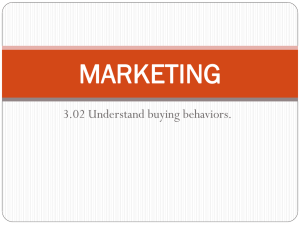
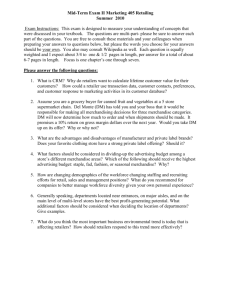

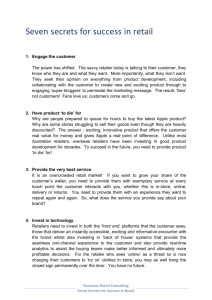
![[DATE] Mary Ziegler Director Division of Regulations, Legislation](http://s3.studylib.net/store/data/007212021_1-b96b03cd98cadfc74a22865c0247494d-300x300.png)
